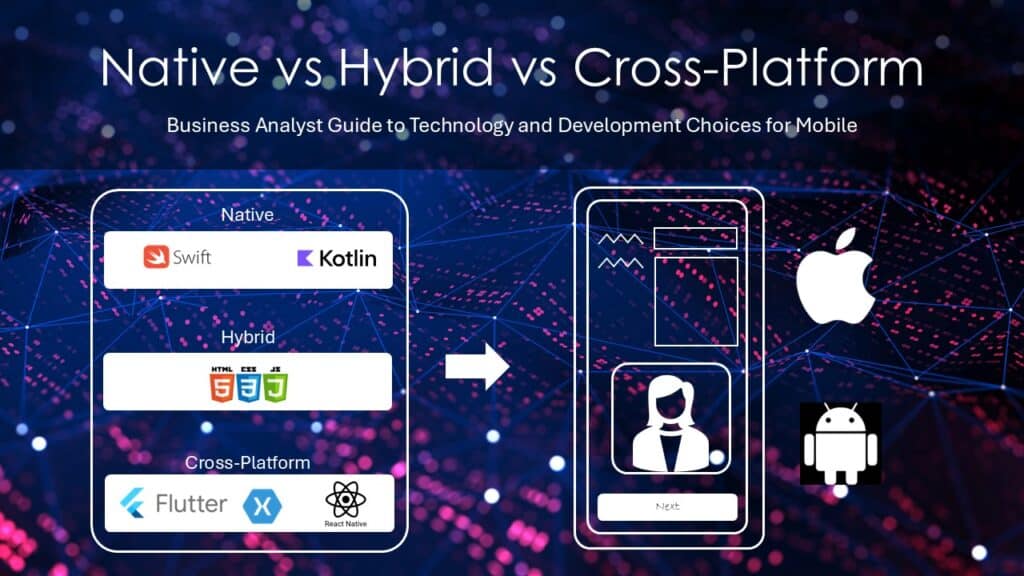Exploring Native, Hybrid, and Cross-Platform Mobile Apps: A Business Analyst’s Guide to Technology and Development Choices
As businesses continue to embrace mobile technology to reach and engage customers, selecting the right approach to mobile app development has become a critical decision. Business Analysts (BAs) play a key role in guiding this choice, balancing technical requirements, business objectives, and user expectations. This post delves into the three primary mobile development approaches—native, hybrid, and cross-platform—along with their technology language options, from a BA’s perspective.
1. Native Apps: Maximizing Performance and User Experience
Overview: Native apps are built specifically for a single mobile operating system (OS), such as iOS or Android, using platform-specific programming languages and development tools. These apps are designed to fully leverage the hardware and software capabilities of the device, offering the best possible performance and user experience.
Technology Language Options:
- iOS (Apple)
- Swift: A modern, efficient language developed by Apple, known for its performance and safety. It is the preferred choice for iOS development.
- Objective-C: An older language still in use, particularly in legacy applications, though largely being replaced by Swift.
- Android (Google)
- Kotlin: The preferred language for Android development, fully supported by Google, known for its conciseness and safety features.
- Java: Historically the main language for Android, still widely used but increasingly supplanted by Kotlin.
Considerations for Business Analysts:
- Performance: Native apps offer the highest level of performance, making them ideal for applications requiring intensive processing, complex animations, or access to specific device features.
- User Experience: These apps can fully align with the design guidelines of their respective platforms, providing a polished and consistent user experience.
- Cost and Time: Developing separate codebases for iOS and Android increases both the time and cost of development, which must be factored into project planning.
When to Choose Native Apps:
- When performance is critical, such as in gaming, AR/VR, or high-fidelity media applications.
- When delivering a best-in-class user experience is a top priority.
- When deep integration with platform-specific features is required.
2. Hybrid Apps: Cost-Effective with Web Technologies
Overview: Hybrid apps are essentially web applications wrapped in a native shell. They are built using web technologies like HTML, CSS, and JavaScript and can be deployed across multiple platforms using a single codebase. The native shell allows the app to be installed on devices like a native app and access some native features.
Technology Language Options:
- HTML/CSS/JavaScript: Core languages used to create the user interface and functionality within the hybrid app.
- Frameworks:
- Apache Cordova: Enables the development of hybrid apps by allowing web code to be packaged as a native app.
- Ionic Framework: Built on Cordova, Ionic provides pre-built UI components and native plugins for building hybrid apps.
Considerations for Business Analysts:
- Development Efficiency: Hybrid apps allow for faster development and deployment across multiple platforms using a single codebase, reducing time and cost.
- User Experience Trade-Offs: While cost-effective, hybrid apps may not deliver the same performance or seamless user experience as native apps, especially for complex applications.
- Maintenance: Hybrid apps are easier to maintain due to their single codebase, but compatibility issues can arise with platform updates, requiring additional support.
When to Choose Hybrid Apps:
- When budget and time constraints are significant, and the app doesn’t require heavy processing or advanced features.
- When the app primarily delivers content or requires simple interactions.
- When targeting multiple platforms quickly with minimal resource investment.
3. Cross-Platform Solutions: Balancing Performance and Development Efficiency
Overview: Cross-platform apps are developed using a single codebase but are compiled into native binaries for different platforms. Unlike hybrid apps, cross-platform solutions provide near-native performance and a consistent user experience across platforms.
Technology Language Options:
- Flutter (Google):
- Dart: The language used by Flutter, known for its fast compilation and performance, allowing the development of high-quality native interfaces.
- React Native (Meta):
- JavaScript: Used to build apps with React Native, leveraging React’s component-based architecture to create native-like interfaces.
- Xamarin (Microsoft):
- C#: Used to build cross-platform apps with Xamarin, enabling code reuse across iOS, Android, and Windows.
Considerations for Business Analysts:
- Performance vs. Efficiency: Cross-platform solutions strike a balance between the high performance of native apps and the cost-efficiency of hybrid apps. While they may not fully match native performance, they come close enough for most use cases.
- User Experience: These solutions provide a more consistent and platform-appropriate user experience than hybrid apps, though slight differences may still exist.
- Development Speed: Cross-platform tools accelerate development and reduce costs by enabling code reuse across platforms, making them a strong choice for many businesses.
When to Choose Cross-Platform Solutions:
- When aiming to deliver a high-quality app across multiple platforms without maintaining separate codebases.
- When the app’s performance needs are moderate, such as in business apps or social media platforms.
- When a quick time-to-market is important, but without sacrificing too much on user experience.
Conclusion: Choosing the Right Approach
From a Business Analyst’s perspective, selecting the appropriate mobile app development approach requires a deep understanding of the project’s objectives, target audience, budget, and timeline.
- Native apps are best for delivering top-tier performance and user experience.
- Hybrid apps offer a cost-effective solution for simpler applications with limited resource needs.
- Cross-platform solutions provide an optimal middle ground, combining efficient development with good performance and user experience.
By evaluating these factors and understanding the technology options available, BAs can guide their teams toward the most effective development strategy, ensuring the final product aligns with both business goals and user expectations.

